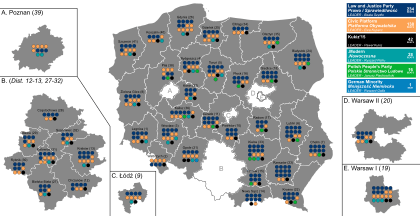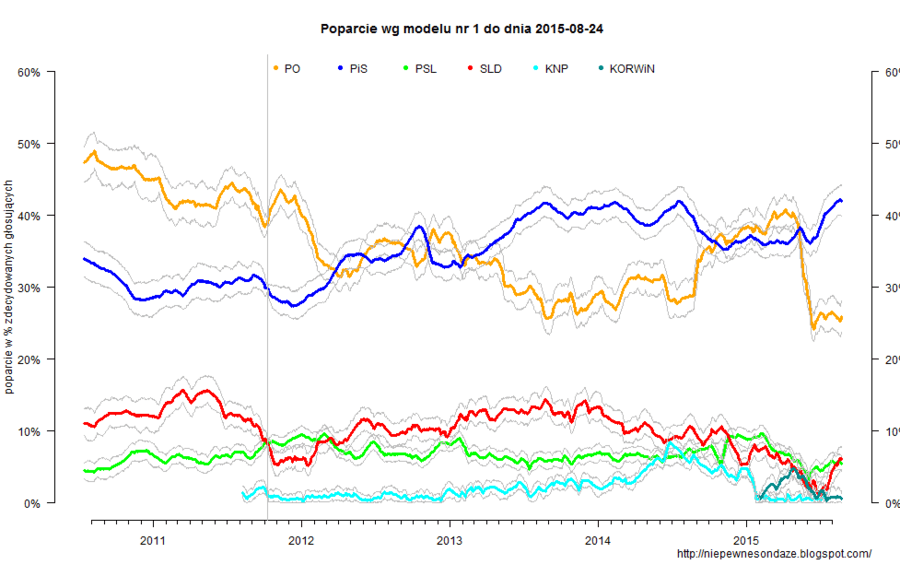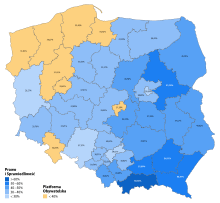Polish parliamentary election, 2015
|
| |||||||||||||||||||||||||||||||||||||||||||||||||||||||||||||||||||||||||||||||||||||||||||||||||||||
| |||||||||||||||||||||||||||||||||||||||||||||||||||||||||||||||||||||||||||||||||||||||||||||||||||||
All 460 seats to the Sejm of Poland 231 seats are needed for a majority in the Sejm All 100 seats to the Senate of Poland | |||||||||||||||||||||||||||||||||||||||||||||||||||||||||||||||||||||||||||||||||||||||||||||||||||||
|---|---|---|---|---|---|---|---|---|---|---|---|---|---|---|---|---|---|---|---|---|---|---|---|---|---|---|---|---|---|---|---|---|---|---|---|---|---|---|---|---|---|---|---|---|---|---|---|---|---|---|---|---|---|---|---|---|---|---|---|---|---|---|---|---|---|---|---|---|---|---|---|---|---|---|---|---|---|---|---|---|---|---|---|---|---|---|---|---|---|---|---|---|---|---|---|---|---|---|---|---|---|
| Turnout | 50.92% | ||||||||||||||||||||||||||||||||||||||||||||||||||||||||||||||||||||||||||||||||||||||||||||||||||||
| |||||||||||||||||||||||||||||||||||||||||||||||||||||||||||||||||||||||||||||||||||||||||||||||||||||
 Seats won by Sejm District | |||||||||||||||||||||||||||||||||||||||||||||||||||||||||||||||||||||||||||||||||||||||||||||||||||||
| |||||||||||||||||||||||||||||||||||||||||||||||||||||||||||||||||||||||||||||||||||||||||||||||||||||
Parliamentary elections to both the Sejm and Senate were held in Poland on 25 October 2015.
The election was won by the largest opposition party Law and Justice (PiS) with 37.6% of the vote against the governing Civic Platform (PO), which achieved 24.1%. Official results, announced on 27 October, gave Law and Justice 235 of 460 seats (51 percent), a majority of four.[3] PiS vice chairwoman Beata Szydło succeeded PO leader Ewa Kopacz as Prime Minister of Poland, heading a one-party cabinet.
It was the first election for a national parliament in Europe since the 1993 Norwegian elections in which the two largest parties were led by a female candidate, and the second election in history (also since the 1993 Norwegian election) where more than three parties fielded female leadership candidates. It was also the first election in Poland since the restoration of full democracy in 1991 (the 1989 elections were only partially free as the Communists and their then-allies had a guaranteed majority) that a party won an absolute majority in the Sejm.
Electoral system
The process of election for the Sejm is through open party-list proportional representation via the D'hondt method in multi-seat constituencies, with a 5% threshold for single parties and 8% threshold for coalitions (requirements waived for ethnic minorities). The senate is elected using first-past-the-post voting in single-member districts.[4] To be included on a ballot, a senate candidate must present 2,000 signatures of support from their constituents.[5] For Sejm elections, the threshold is 5,000 signatures per constituency, though that requirement is waived for parties that have already registered lists in at least half of all constituencies (21 out of 41 as of this election).[6]
Overall, the Sejm includes 460 MPs. Should a party have 231 or more deputies in Parliament, it has an absolute majority and can thus govern autonomously, without the need for support from other parties. The constitution can be amended with a supermajority of two-thirds, or 307 deputies.
Election date
The date of the election, 25 October, was set by the previous President of Poland, Bronisław Komorowski.[7] The latest possible date for the election to be held was in November 2015, four years after the previous election. Prior to the announcement of the election date, the most likely dates were thought to be in October or November.
In the previous parliamentary elections in 2011 the Civic Platform–Polish People's Party coalition government, in power since 2007, won a second term. All 460 seats in the Sejm and 100 seats in the Senate were up for election.
Parties standing in the election
Nationwide committees
Regional committees
Opinion polls

Results
The opposition party, Law and Justice won the election with 37.58% of the vote against the governing Civic Platform, which gained a 24.09% share.[33] Beata Szydło became the new Prime Minister, succeeding Ewa Kopacz.[34][35]



| Parties | Sejm | Senate | ||||||
|---|---|---|---|---|---|---|---|---|
| Votes | % | ±% | Seats | ± | Seats | ± | ||
| Law and Justice (Prawo i Sprawiedliwość, PiS) | 5,711,687 | 37.58 | 235 / 460 |
61 / 100 |
||||
| Civic Platform (Platforma Obywatelska, PO) | 3,661,474 | 24.09 | 138 / 460 |
34 / 100 |
||||
| Kukiz'15 (K'15) | 1,339,094 | 8.81 | 42 / 460 |
— | ||||
| Modern (Nowoczesna, .N) | 1,155,370 | 7.60 | 28 / 460 |
— | ||||
| United Left (Zjednoczona Lewica, ZL) | 1,147,102 | 7.55 | —[lower-alpha 1] | — | ||||
| Polish People's Party (Polskie Stronnictwo Ludowe, PSL) | 779,875 | 5.13 | 16 / 460 |
1 / 100 |
||||
| KORWiN | 722,999 | 4.76 | — | — | ||||
| Together (Partia Razem) | 550,349 | 3.62 | — | — | ||||
| Regional committees | ||||||||
| Committee of Zbigniew Stonoga (KWW ZS) | 42,731 | 0.28 | — | — | ||||
| German Minority (Mniejszość Niemiecka, MN) | 27,530 | 0.18 | 1 / 460 |
— | ||||
| United for Silesia (Zjednoczeni dla Śląska, ZdŚ) | 18,668 | 0.12 | — | — | ||||
| JOW Bezpartyjni | 15,656 | 0.10 | — | — | ||||
| Committee of Grzegorz Braun "God Bless You!" (Szczęść Boże!) | 13,113 | 0.09 | — | — | ||||
| Congress of the New Right (Kongres Nowej Prawicy, KNP) | 4,852 | 0.03 | — | — | ||||
| Self-Defence (Samoobrona) | 4,266 | 0.03 | — | — | ||||
| Social Movement of the Republic of Poland (Ruch Społeczny) | 3,941 | 0.03 | — | — | ||||
| Citizens to Parliament (Obywatele do Parlamentu, OdP) | 1,964 | 0.01 | — | — | ||||
| Independents (Niezależni) | N/A | N/A | N/A | N/A | N/A | 4 / 100 |
||
| Total | 15,200,671 | 100 | 460 | 100 | ||||
Notes
- ↑ United Left was running as a coalition, therefore was subject to an 8% election threshold rather than 5% for single parties.
The perceived winner of the election was Law and Justice, which made history as the first and only party in Poland to win majority government in a free election, since 1991. The other parties considered winners were two newcomer parties, Kukiz's Movement (third place) and Ryszard Petru's Modern party (4th place).
Two of the biggest losers were Civic Platform and the Polish People's Party. PO suffered its worst result in a parliamentary election in ten years, ending eight years of political dominance. The PSL, the junior partner in the outgoing government, had its worst result in 25 years (5.13%), just crossing the 5% threshold by a few thousand votes. Another perceived loser was the Democratic Left Alliance, Poland's largest left-wing party, which failed to win a seat for the first time in a quarter of a century. The SLD ran as the largest partner of the United Left, which was 0.5% short of the 8% threshold for electoral alliances to win seats.
Reactions
Political analysts noted that the election marked the first time in the post-communist era that a political party received enough votes to form a majority government.[37][38] BBC News suggested that Law and Justice's strategy of putting forward Szydło as its candidate for prime minister was a "winning formula" in the election. Szydło was widely perceived as being more moderate than PiS' outspoken leader, Jarosław Kaczyński. However, it also noted that Kaczyński could step into the role of prime minister after the election.[38]
According to the Associated Press, the new Sejm was the most right-wing parliament in Europe due to the absence of centre-left MPs in the chamber. All five parties in the Sejm tilted rightward on social issues. Between them, left-leaning alliances only gained 11 percent of the vote.[39]
Kopacz swiftly conceded defeat after exit polls from TVP showed PiS on its way to a majority, while Kaczyński declared victory and hailed his party's historic majority.[40] Kaczyński also paid tribute to his late brother, President Lech Kaczyński, who died in the 2010 plane crash.[35]
See also
References
- ↑ "Poland's shock election result has just made the EU even more of a mess – Spectator Blogs". Spectator Blogs. Archived from the original on 27 October 2015.
- ↑ http://uatoday.tv/society/poland-508355.htm
- ↑ "Poland's Eurosceptics win outright majority in parliament". Reuters. Retrieved 27 October 2015.
- ↑ Álvarez-Rivera, Manuel (17 October 2015). "Election Resources on the Internet: Elections to the Polish Sejm, Part I". electionresources.org. Retrieved 25 October 2015.
- ↑ "Notes on the Senate" (PDF). Senate of Poland. Retrieved 25 October 2015.
- ↑ "Sejm of the Republic of Poland". Sejm. Retrieved 25 October 2015.
- ↑ Rylukowski, Wojciech (17 July 2015). "Komorowski announces elections date". Warsaw Business Journal. Retrieved 25 October 2015.
- ↑ "Polish premier's departure leaves party facing test". Financial Times.
- ↑ "Origin, Ideology and Transformation of Political Parties". google.de.
- ↑ "Pension Reforms in Central, Eastern, and Southeastern Europe". google.de.
- ↑ Copsey, Nathaniel (2013). Poland:An Awkward Partner Redeemed. The Member States of the European Union (Second ed.). Oxford University Press. p. 191.
- ↑ Szczerbiak, Aleks (2012). Poland Within the European Union: New awkward partner or new heart of Europe?. Routledge. p. 2.
- ↑ De Waele, Jean-Michel; Pacześniak, Anna (2012). The Europeanisation of Poland's political parties and party system. Europeanisation and Party Politics. ECPR Press. p. 125.
- ↑ Easton, Adam (7 October 2011). "Poland heads into close-fought election". BBC News. Retrieved 5 June 2012.
- ↑ "Poland's crumbling government". The Economist. 25 September 2006. Retrieved 5 June 2012.
- ↑ "Law and Justice". Encyclopædia Britannica Online. Encyclopædia Britannica. Retrieved 7 June 2012.
- ↑ Szczerbiak, Aleks (2012), Poland Within the European Union: New awkward partner or new heart of Europe?, Routledge, pp. 1, 13
- ↑ Porter-Szűcs, Brian (2011), Faith and Fatherland: Catholicism, Modernity, and Poland, Oxford University Press, p. 201
- ↑ Minkenberg, Michael (2007), "Between Tradition and Transition: the Central European Radical Right and the New European Order", Europe for the Europeans: The Foreign and Security Policy of the Populist Radical Right, Ashgate, p. 261
- ↑ Jennifer Lees-Marshment (2 July 2009). Political Marketing: Principles and Applications. Routledge. pp. 103–. ISBN 978-1-134-08411-1.
- ↑ "Poland's United Left puts forward candidate for PM". Polskie Radio dla Zagranicy.
- 1 2 "Do Zjednoczonej Lewicy dołączył nowy koalicjant". interia.pl. 14 September 2015.
- ↑ "United Left presents its new leader and PM candidate". WBJ.
- ↑ "Start – Zjednoczona Lewica". Zjednoczona Lewica.
- 1 2 Bundeszentrale für politische Bildung. "Marxismus". bpb.de.
- ↑ "Where Does the Left Come From?". internationalviewpoint.org.
- ↑ "Polska Partia Pracy". partiapracy.pl.
- ↑ "Maverick MEP Korwin-Mikke launches new party". Polskie Radio dla Zagranicy.
- ↑ "Maverick MEP Korwin-Mikke launches new party – National". Thenews.pl. 23 January 2015. Retrieved 5 March 2015.
- ↑ Rightist Party That Made Auschwitz Joke Wins Polish Elections Haaretz, 27 October 2015
- ↑ "Kulturalny flesz dnia: KUKIZ vs. PIERSI, WILDSTEIN vs. PESZEK, SHIRLEY TEMPLE". wpolityce.pl.
- ↑ Poland expected to turn inward under right-wing party Washington Post, 26 October 2015
- ↑ Lyman, Nick (25 October 2015). "Law and Justice Party Wins in Poland's Parliamentary Elections". New York Times. Retrieved 25 October 2015.
- ↑ "Poland conservatives 'win election'". BBC News. Retrieved 25 October 2015.
- 1 2 Cienski, Jan (25 October 2015). "Polish right sweeps parliamentary elections". Politico. Retrieved 25 October 2015.
- ↑ "KOMUNIKAT PAŃSTWOWEJ KOMISJI WYBORCZEJ z dnia 26 października 2015 r. o zbiorczych wynikach głosowania na listy kandydatów na posłów w skali kraju" (PDF) (in Polish). pkw.gov.pl. October 26, 2015. Retrieved October 27, 2015.
- ↑ "Poland Ousts Government as Law & Justice Gains Historic Majority". Bloomberg. 25 October 2015. Retrieved 25 October 2015.
- 1 2 "Poland elections: Conservatives secure decisive win". 25 October 2015. Retrieved 25 October 2015.
- ↑ Gaeta, Vanessa (2015-10-28). "Left wing is shut out in parliamentary vote in conservative Poland". The Boston Globe. Associated Press.
- ↑ "Eurosceptic conservatives win Polish election – exit poll". RTÉ News. 25 October 2015. Retrieved 25 October 2015.

.jpg)